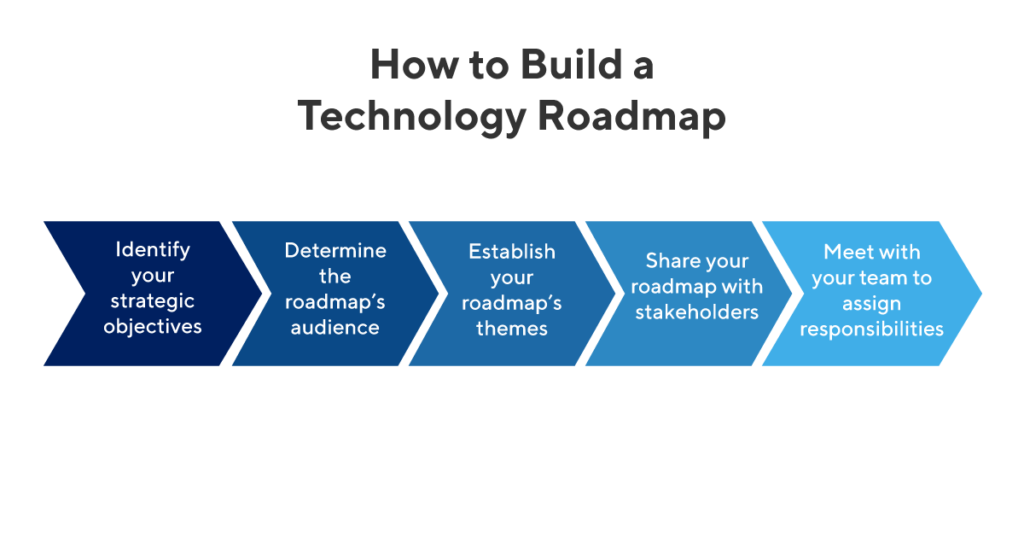What is a Technology Roadmap?
A technology roadmap is a high-level visual summary that maps out the vision and plans for a complex technology undertaking. Businesses use technology roadmaps to plan and manage internal IT projects.
When and Why Would You Need a Technology Roadmap?
Making any change to a business’s technology environment can be a complicated task. It can also create a ripple effect across the organization.
If the company implements a change without thinking through the implications, it could create problems for the business’s operations. It could also introduce security and regulatory weaknesses. And even if the company addresses these risks, the change itself could be disruptive.
For these reasons, a business should use a technology roadmap to strategically plan any complex adjustment to its IT environment, including addressing technical debt. Using a technology roadmap can help a company plan out the best way to introduce a technological change in the business. This plan would include rolling out new software for employees, upgrading the organization’s digital network, or migrating to a new email program.
Here are a few other benefits of technology roadmaps.
What are the Benefits of a Technology Roadmap?
1. It helps you see and understand the implications of your plan.
Before introducing any IT changes to your organization, you need to think through how the change will affect the business.
For instance, are you thinking about upgrading to new servers? You’ll need to know how moving your data will affect your employees’ work. You’ll also need to figure out how to make the switch without leaving any holes in your cybersecurity process.
A technology roadmap helps you and your team think through how your plans will impact other areas of the business.
2. It helps you communicate your plan’s big-picture goals and benefits.
When you decide to change corporate email systems or some other aspect of your IT environment, you will need to earn the support of affected stakeholders across the company.
A technology roadmap can help you do this by allowing you to clearly and persuasively summarize your strategic thinking behind your plan, and the benefits you anticipate the change will deliver to the company.
3. It helps keep your team on track during the process.
All complex projects face obstacles. Your executive staff might freeze budgets across the company while your technology implementation is only halfway complete. Or an IT emergency in the company might force your team to pause on this project while you address that urgent problem.
When you can refer to a technology roadmap that summarizes your high-level plans and strategic thinking, you will always be dealing with unexpected challenges like these by taking a step back and reassessing your project’s big-picture plans and priorities. This assessment will give you the perspective you need to make smart choices about how to respond when things don’t go as planned.

How to Create a Technology Roadmap
Here’s a five-step plan for building a technology roadmap.

Step 1: Identify your strategic objectives.
Before you can plan the specific tactics of your technology project, you need to figure out why you’ve decided this initiative is essential. That means your first step is to identify and clearly articulate the “why” behind your proposed change.
Ask yourself, “How will this IT change benefit our business?” — and place your brief response at the top of your technology roadmap.
Step 2: Determine the roadmap’s audience(s).
You might be planning highly technical changes for your company. But if you’re going to present this roadmap to your executive staff, you don’t want it to read like a technical manual. Those executives might not understand any of the terms you use in conversation to discuss this project with your IT coworkers.
Figure out which audiences will be viewing your technology roadmap, so you can build the roadmap using language those people will understand. If you plan to share the roadmap with more than one audience, you will want to use web-based roadmap software. It allows you to quickly and easily build several versions of the same roadmap and switch effortlessly among the different views during your presentations.
Step 3: Establish your roadmap’s major themes.
Now that you’ve decided on your primary strategic goals, it’s time to turn those goals into a plan. You’ll want to start with the highest-level actions. You can then drill down into each to figure out the details.
Note: The high-level strategic elements on a roadmap are called themes, followed by epics. (Several related epics can fall under one high-level theme.)
Step 4: Share your roadmap with relevant stakeholders
When your technology roadmap is ready to share with key stakeholders, you should call a meeting with them. At this stage, you should have a compelling message about why this technology change will help the business and a clear vision of how you plan to execute it.
Expect your stakeholders — particularly your executive team — to ask you to explain both points.
Step 5: Meet with your team to assign responsibilities — and start making progress.
Once you have your themes and epics in place, you will need to translate those high-level plans into actionable tasks.
Bring your team together to review your technology roadmap. In this meeting, you will want to determine which projects to work on in which order, estimate how long each project will take, and decide which team members will be responsible for each action item.
One final suggestion: Review and reassess your roadmap often.
The projects covered in a technology roadmap typically take months to complete. And because your team’s priorities can change many times during that period, you’ll want to review your technology roadmap regularly throughout the process. That way, your team is continuing to make progress according to your original plan and goals.
Tips for Sharing Your Technology Roadmap
In Step 4 of our process above, we suggested you present your roadmap to relevant stakeholders, so they can understand — and, with any luck, support — your proposed technology implementation. How can you improve your chances of making that meeting a success? Here are a few tips for sharing your technology roadmap:
1. Talk benefits, not tactics.
Until they know how your technology plan will benefit the business, your coworkers and executives won’t care how you plan to accomplish it.
Start with your big-picture thinking. Tell your audience why you’re proposing this change. Then explain what you expect it to do for the company, and why you’re sure it’s a smart move.
Note: Even if you are not presenting the roadmap to an audience but simply sharing it digitally with coworkers, you still want to follow this approach of explaining the big “why” behind your plan. So, make sure you include a short description of the strategic benefits right at the top of your technology roadmap.
2. Leave the technical details out.
Your roadmap should be visually compelling, and it should tell a story your audience can digest within a few seconds after you’ve put the roadmap up on the conference room’s screen.
Be concise. For each epic or theme on the roadmap, explain in just a few words what you plan to do, what you anticipate it will achieve for the company, and why that’s a good thing.
3. Have evidence to support your claims.
There is one caveat to our suggestion — that you keep the details out of your roadmap. You should have some data supporting your plans and goals somewhere in the roadmap.
With the right roadmap app, of course, you can add relevant stats, charts, or links to data beneath each item; keeping that information hidden from view until you’re ready to present it. You’ll keep your roadmap presentation clean and free of clutter, but still be able to pull up evidence immediately if someone challenges you or asks for supporting data.
Ready to build your own roadmap? 




